| Columns Retired Columns & Blogs |
It flowed for me in much the same way I think the Evo 400 did for you.
The PrimaLuna EVO 400 arrived without the eight EL34 output tubes installed, just the six 12AU7 small-signal tubes. Neither the EL34s nor the sockets are numbered, so I assumed that PrimaLuna's Adaptive Auto Bias system would ensure that the tubes were optimally biased after I installed them. (As recommended for EL34s in the manual, I made sure that the bias switch on the right side of the chassis was set to Low.) None of the four red LEDs for each channel's tube condition illuminated during the testing, which meant that PrimaLuna's BTI circuit didn't detect a bad tube. I measured the EVO 400 with my Audio Precision SYS2722 system, performing a complete set of tests from each of the 8 ohm and 4 ohm taps in both Ultralinear and Triode output modes, repeating some tests from the headphone output. The review sample was not fitted with the optional PhonoLogue moving magnet phono stage.
The EVO 400's unbalanced input impedance was a usefully high 33k ohms at 20Hz and 1kHz, dropping inconsequentially to 29k ohms at 20kHz. The PrimaLuna amplifier preserved absolute polarity from both output transformer taps and from the headphone output. The amplifier's maximum voltage gain at 1kHz into 8 ohms depended on the output mode and tap. The highest gain was from the 8 ohm tap in Ultralinear mode, at 37.3dB. The gain from the 8 ohm tape in Triode mode was 1.3dB lower. The gains from the 4 ohm tap into 8 ohms were 36dB in Ultralinear mode and 33.8dB in Triode mode. The maximum gain from the headphone output was 20.15dB.
The amplifier's output impedance also depended on the output mode and tap. The highest impedance was from the 8 ohm tap in Ultralinear mode, at 2.5 ohms at 20Hz and 1kHz, rising to 3.3 ohms at 20kHz. This resulted in ±1.4dB variations in frequency response with our standard simulated loudspeaker (fig.1, gray trace). The output impedance from the 8 ohm tap in Triode mode was slightly lower, ranging from 2.25 ohms to 2.85 ohms, which reduced the variations in response to ±1.2dB (fig.2, gray trace). As expected, the 4 ohm tap featured the lowest output impedance: 1.45 ohms at 20Hz and 1kHz, 1.8 ohms at 20kHz, in Ultralinear mode; 1.3 ohms at 20Hz and 1kHz, 1.6 ohms at 20kHz, in Triode mode. The headphone output's source impedance was a low 3.2 ohms across the audio band.
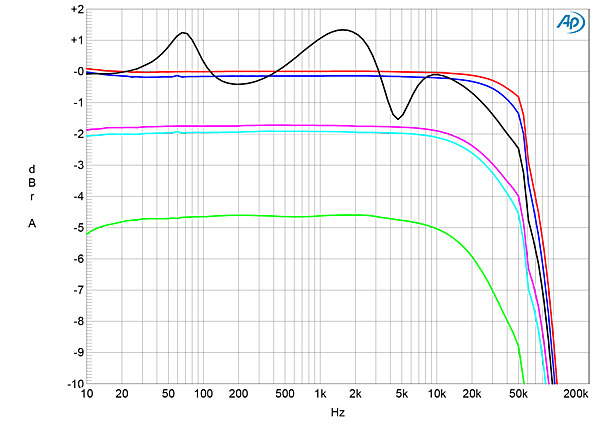
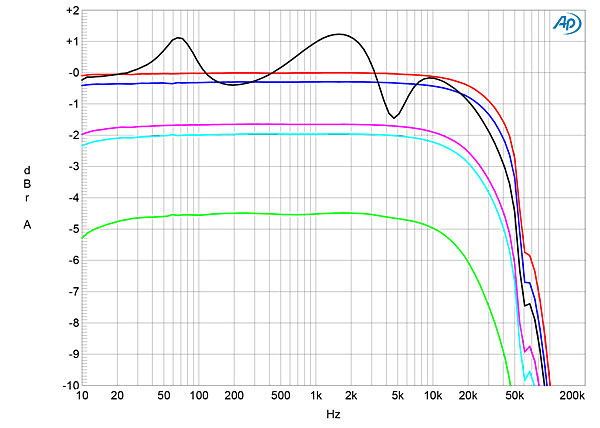
Into resistive loads, the small-signal response from both transformer taps was flat almost to 20kHz and rolled off above that frequency (blue, red, cyan, magenta, and green traces in figs.1 and 2). A residual resonance just below 70kHz can be seen in the ultrasonic rolloff. This resonance is well-damped, however, with just one cycle of ringing visible with the amplifier's reproduction of a 10kHz squarewave (fig.3).
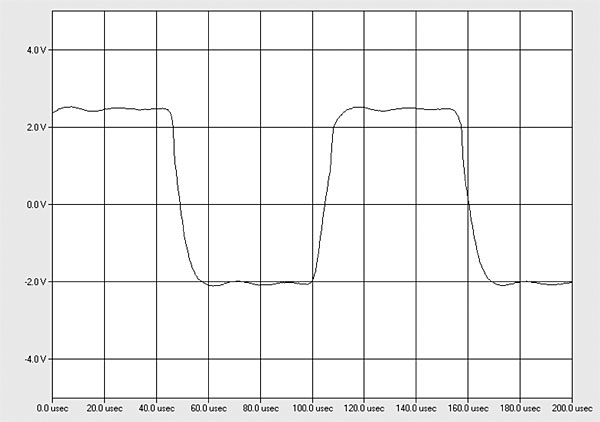
Figs.1 and 2 were taken with the volume control set to its maximum, where the channel matching was within 0.1dB. The excellent matching was maintained at lower settings of the control, but peculiarly, the right channel lagged the left channel by a second or so in reaching the new level when the volume was changed. L–R channel separation was good below 2kHz, at 70dB, but 50dB in the other direction. The separation reduced to 56dB and 38dB, respectively, at the top of the audioband.
Measured at the 8 ohm taps and taken with the inputs shorted to ground and the volume control at its maximum, the amplfier's unweighted, wideband signal/noise ratio in Ultralinear mode was 64dB in the left channel, 67.5dB in the right channel, ref. 1W into 8 ohms. These ratios respectively improved slightly to 65.3dB and 70.2dB when the measurement bandwidth was restricted to the audioband, and to 70.3dB and 74.8dB when A-weighted. The S/N ratios in Triode mode were 2–3dB higher, and were 3dB higher again from the 4 ohm tap. The main power supply–related spuriae in the EVO 400's noisefloor were at 60Hz and 120Hz and the random noise level was a little higher in the left channel (fig.4, blue trace) than the right (red trace), which correlates with the lower S/N ratios in that channel.
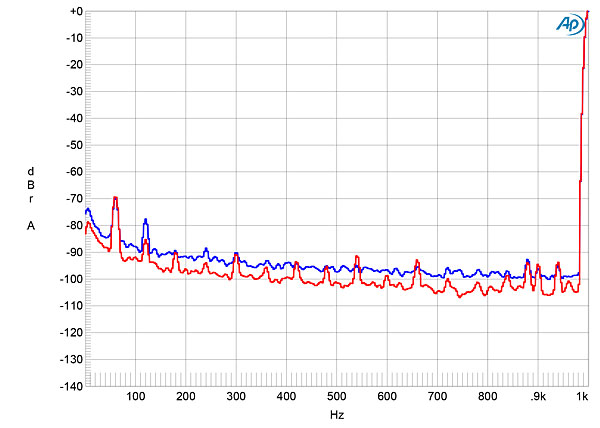
Fitted with EL34 output tubes, the PrimaLuna amplifier is specified as delivering 38Wpc into 8 ohms in Triode mode (15.8dBW) and 70Wpc into 8 ohms in Ultralinear mode (18.4dBW). Using our definition of clipping, which is when the output's THD+noise percentage reaches 1%, with both channels driven with a 1kHz signal the EVO 400's 8 ohm tap in Ultralinear mode clipped at 63Wpc into 8 ohms (18.0dBW, fig.5). Relaxing the definition of clipping to 3% THD+N gave the specified power of 70Wpc into 8 ohms. In Triode mode, the 8 ohm tap gave 33Wpc (15.2dBW) at 1% THD+N and 39Wpc (15.9dBW) at 3% THD+N (fig.6). Similar maximum powers at 3% THD+N were available from the 4 ohm tap when driving 4 ohms: 67Wpc (15.25dBW) in Ultralinear mode and 37Wpc (12.67dBW) in Triode mode.
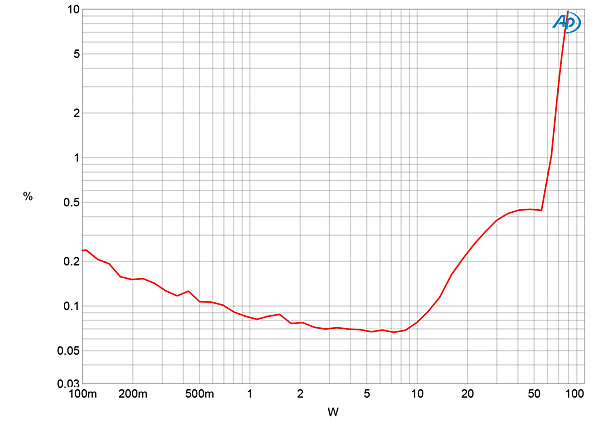
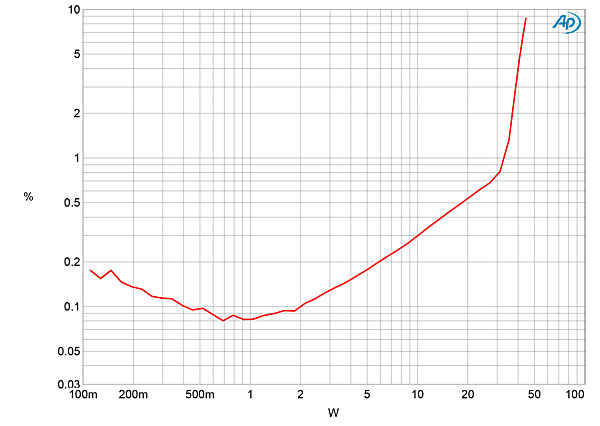
The traces in figs.5 and 6 were taken with the left channel and the distortion levels in both output modes dropped below 0.1% at low powers. Although I haven't shown the relevant graphs, the distortion at moderate powers was even lower when the output transformer tap was driving a load higher than its nominal value. I plotted how the THD+N percentage changed with frequency at 4.9V from the 4 ohm tap—a voltage that is equivalent to 3W into 8 ohms, 6W into 4 ohms, and 12W into 2 ohms—in both Ultralinear mode (fig.7) and Triode mode (fig.8). These graphs show that the distortion was significantly higher in the right channel (red, magenta, and gray traces) than the left (blue, cyan, and green). It is possible that the tubes were not as well-matched in the right channel as in the left. (The more closely the tubes are matched in a push-pull design, the lower the level of even-order distortion.) The distortion also rises at the frequency extremes and into loads that are equal to or below the nominal transformer tap impedance.
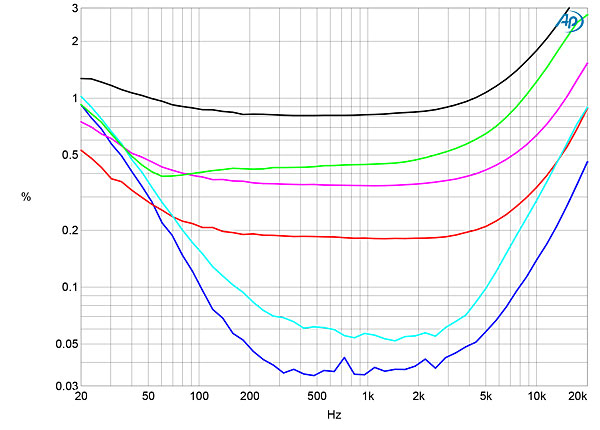
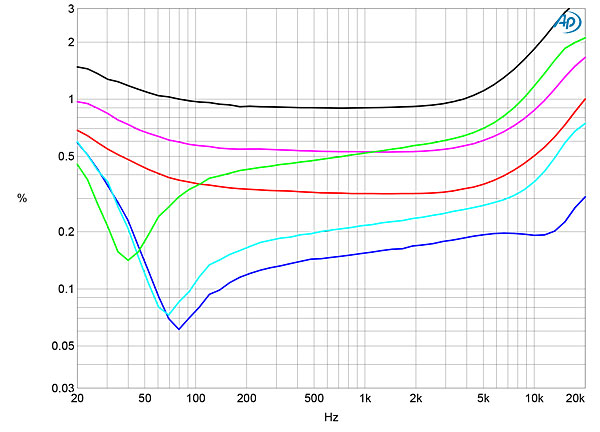
Fortunately, the EVO 400's distortion was predominantly the sonically benign second harmonic (fig.9), though as expected it was higher in level in the right channel (fig.10). This graph also shows that at low frequencies the third harmonic makes an appearance, though it is lower in level at higher frequencies (fig.11). When the amplifier drove an equal mix of 19 and 20kHz tones at a peak level of 3W into 8 ohms from the 8 ohm tap (fig.12), the second-order difference product at 1kHz ay at –57dB (0.14%) in both channels and the higher-order intermodulation products were all below –66dB (0.05%). The graph was taken in Triode mode; intermodulation distortion in Ultralinear mode was similar in level.
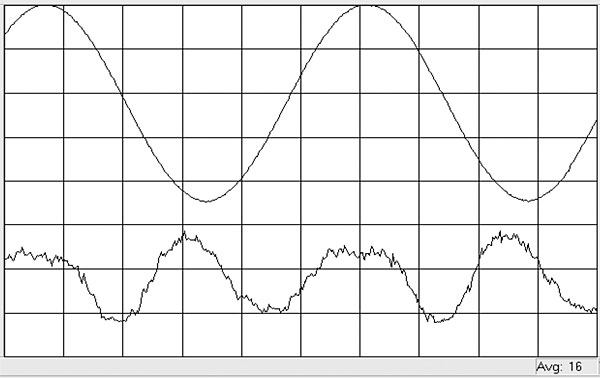
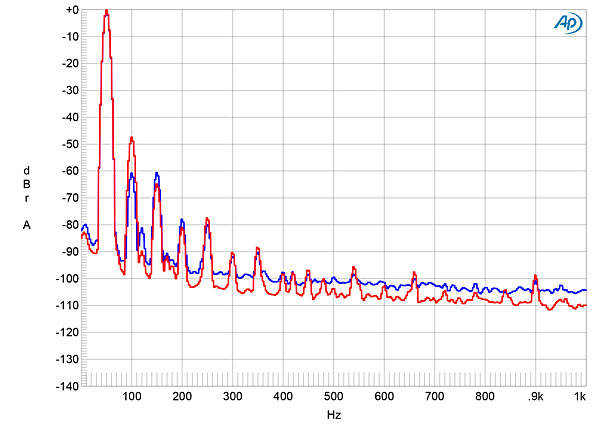
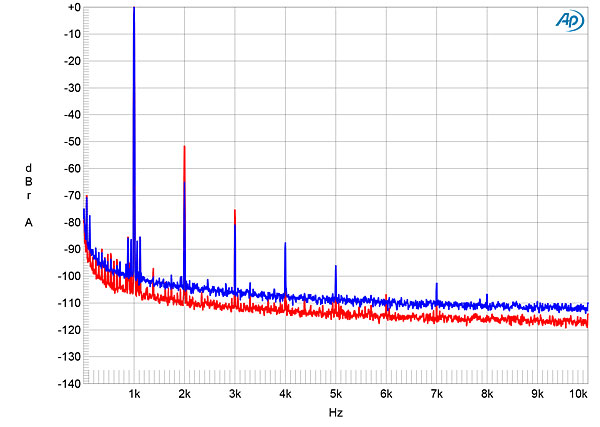
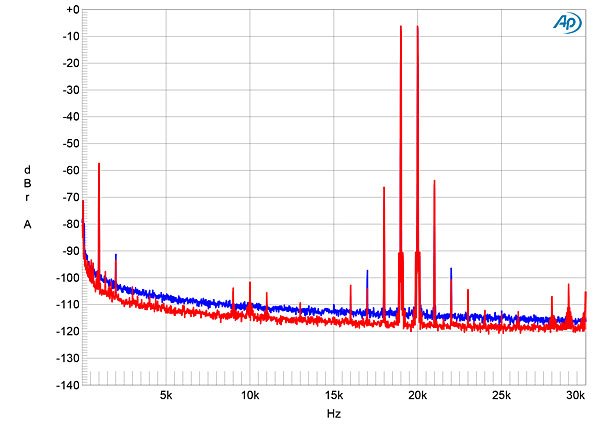
Other than the higher level of second-harmonic distortion in the right channel, the PrimaLuna EVO 400's performance on the test bench was what I would expect from an amplifier with a push-pull output stage that uses paralleled EL34 tubes. The test results suggest that the lowest distortion will be obtained with the 4 ohm tap in Ultralinear mode.—John Atkinson

It flowed for me in much the same way I think the Evo 400 did for you.

Thanks for that kindness — glad you enjoyed the review!

Or I assume it was more complex than that..?

...I wouldn't say the amp is in any way hamstrung with the stock EL34s. It sounds lovely either way. With the KT150 valves, I get marginally better control of the lower bass, and a more expansive soundstage. It's not night and day though. If you do decide to try the KT150s, I'd wait a while until prices stabilize. The tube market's kinda crazy right now. I have a feeling that tube costs will be lower in the fall, or whenever Russia decides to end its ill-advised invasion and sanctions are lifted.

Enjoyed the mentions of Mesa Baron and Jolida. A Jolida was the first tube amp I heard, back in college. And I still use Mesa, but for my flying V not for hifi.
I don't find tubes to be that tricky, but it's true that some work better for some purposes than others (echoing Kevin Deal's comment). For 12AU7s in my preamp I have NOS Telefunken and a bugle boy, and for unknown reasons, the music sounds more alive with the bugle boy in the gain stage and the tele as cathode follower. I have Psvanes in a smaller setup, but my ears prefer the NOS tubes from reputable sellers (not ebay), especially for line-stage amplification.

Thanks for the thoughtful review Rogier. I'm just getting into the HiFi universe and am, naturally, tube-curious. Question to all: Can anyone speak to the differences in sound of the 400 as compared to the other PM integrated amps down the food chain? 300, 200, etc.? I prioritize sound-stage and transparency and never play loud. Wondering if the same sound signature that Rogier described can be had by stepping down the line. Thank you in advance!

...there's no significant change in sound signature when you go from the 400 to the 300. I've never heard the 200 or 100 so I can't really speak to that. The folks at Upscale Audio should be able to help. My guess is that as long as your speakers are easy to drive, you'll get nearly identical sonics from the "lower" models. Inefficient speakers will do better with increased amplifier power though.
There's also a PrimaLuna owners group on Facebook where everyday users are probably happy to answer your question: https://www.facebook.com/groups/509067122811946

He said the HOLE in the center of the disc, not the disc itself.
PS -- Love this amp. LOVE LOVE LOVE it. My balm during The Lockdown.

Hi
Why not? Anything made in China will cost much less than made-in-original-country. "World-class" or not is another story.
China is a popular OEM for audios nowadays. So tempting for good profit in selling more quantities for lower pricing due to low cost built offshore. Business is business, no charity !
Jack L

[[Edit: In case there are people reading this who don't know it: Kevin Deal (who wrote this comment) is CEO of Upscale Audio and Upscale Distribution; the former sells and the latter distributes PrimaLuna.--Jim Austin]]
PrimaLuna has been called things much greater than "World Class" The late, great Art Dudley said "I've never seen a better-built amp" with no qualification as to price.
We always tell people don't buy a damn thing without looking inside to make sure you are getting what you paid for and not fairy dust.
PrimaLuna is happy to compare side by side with any product at any price.

Did the PrimaLuna have any difficulty driving the Martin Logans to realistic volume levels? After all, they are not the most efficient speakers, especially with the cone drivers below. I am asking because I drive mine with a Krell amp, which is fine, but I am curious to try tubes.

[[Edit: In case there are people reading this who don't know it: Kevin Deal (who wrote this comment) is CEO of Upscale Audio and Upscale Distribution; the former sells and the latter distributes PrimaLuna.--Jim Austin]]
Rogier can comment, but I thought I might mention there is a guy named Pete Soderberg that worked for MartinLogan for something like 15 years, and he works at Upscale Audio now. Give him a call. Also Sean Smollen. He was a MartinLogan product trainer. They both work at Upscale now.

Hi Rogier
I fully agreed to what you heard about PL in triode mode. This sorta 'smoothing' effect has been the typical sonic downside of trioding pentode/tetriode in so many brandname triode-pentode power amps since day one decades back.
This is the historic conventional simple trioding topology employed by most most, if not all, brandname tube amps manufacturers worldwide. It is done by striping the screen grid (G2) to the anode of the pentode/tetrode in the power output stage, directly or indirectly using a serie low-ohm resistor.
Such simple trioding connection puts the screen grid operating the SAME voltage of the plate. This simple & no-cost triode-pentode mode serves a good selling feature for those triode fan lovers, like your truly.
Yet, sonically it makes the orginal punchy forceful sonics of pentode power amp sounds slow, dull like a leaking tire. That's exactly what you called "it takes the edge off" smoothing effect.
That being the case, why install this trioding feature onto the PrimaLuna amp then ? As a sales feature ignoring/without knowing such bad sounding triode effect ?????
Triode power tube always sounds much better than any pentode/tetrode: fast, transparent, silky & melodic. This is due to the signal transfer curves of a triode being linear vs kinked non-linear transfer curves of a pentode/tetrode, e.g. EL-34 etc. This is physics !!!! That's why so many music lovers like true triode music, including me, needless to say.
Despite your pre-review sales pitch for the Dutch designer, it does not change the sonic pitfall the conventional historic trioding pentrode topology he employed. Either he did not do auditioning of his PrimaLuna triode mode prototype enough or he simply took it for granted.
FYI, since I love true triode sound, I spent enough time to experiment the right topology for good triode sound out of a pentode/tetrode, e,g, EL-34 etc. Mainly for economy reason, as triodes, like 300E, 2A3 are very expensive to own , not-that-durable as pentodes & require much more costly complex circuitry.
Instead of the no-cost conventional 'no-brainer' trioding the pentode, the screen grid G2 is connected to the plate of the pentode, e.g. EL-34 etc, BUT with a stabilized potential difference betwen the screen grid & the plate of certain 'optimum' value.
So the trioded pentode is working like a triode BUT with a stablized potential difference between the plate & the screen grid G2.
The sonic improvement is realy rewarding: the pentode now sound like a true triode: silky, elegant & melodic like a true triode, yet retaining the transient, punchy & forceful sonic of a pentode. A sonic combination of both a triode & pentode !!!
My vintage Dynaco ST-70 has been ungraded to switchable triode/ultra-linear mode, using such "plate-G2 split potential' topology for many years now. No sweat! Yet I always set it to triode mode as it sounds soo much better than its factory orginal UL mode.
Listening is believing
Jack L

Testify brother. But it's not for every person or every situation. That's why the Triode / Ultralinear switch is on the remote. I use triode at night because of what you said. The house becomes relaxed.
And by the way, females often prefer triode because they have more sensitive hearing than men do.